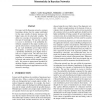Free Online Productivity Tools
i2Speak
i2Symbol
i2OCR
iTex2Img
iWeb2Print
iWeb2Shot
i2Type
iPdf2Split
iPdf2Merge
i2Bopomofo
i2Arabic
i2Style
i2Image
i2PDF
iLatex2Rtf
Sci2ools
UAI
2004
2004
Monotonicity in Bayesian Networks
For many real-life Bayesian networks, common knowledge dictates that the output established for the main variable of interest increases with higher values for the observable variables. We define two concepts of monotonicity to capture this type of knowledge. We say that a network is isotone in distribution if the probability distribution computed for the output variable given specific observations is stochastically dominated by any such distribution given higher-ordered observations; a network is isotone in mode if a probability distribution given higher observations has a higher mode. We show that establishing whether a network exhibits any of these properties of monotonicity is coNPPP -complete in general, and remains coNP-complete for polytrees. We present an approximate algorithm for deciding whether a network is monotone in distribution and illustrate its application to a real-life network in oncology.
| Added | 31 Oct 2010 |
| Updated | 31 Oct 2010 |
| Type | Conference |
| Year | 2004 |
| Where | UAI |
| Authors | Linda C. van der Gaag, Hans L. Bodlaender, A. J. Feelders |
Comments (0)

